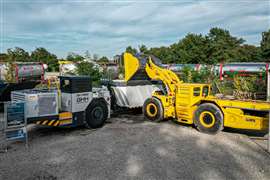Panel discussion offers glimpse into Republican manufacturing priorities
22 July 2024
The AEM/Komatsu panel at the start of the RNC in Milwaukee touched on a variety of manufacturing challenges to be addressed by policymakers.
At a recent panel discussion about equipment manufacturing, Kip Eideberg, senior vice president for Government & Industry Relations at the Association of Equipment Manufacturers (AEM), said American manufacturing was enjoying something of a renaissance.
“Not only are American factories producing more equipment, but America is building more factories,” he said. “For years after the global pandemic, U.S. equipment manufacturing is strong and resilient.”
However, he also noted the hurdles equipment makers face, including labor shortages, a challenging regulatory environment and inaction on several key policy priorities.
 Participating in the policy panel hosted July 15, 2024, by AEM and Komatsu were (L-R) Rep. Brian Steil (R-Wis.), Gov. Glenn Youngkin (R-Va.) and Sen. Bill Hagerty (R-Tenn.). (Photo: KHL/Mitchell Keller)
Participating in the policy panel hosted July 15, 2024, by AEM and Komatsu were (L-R) Rep. Brian Steil (R-Wis.), Gov. Glenn Youngkin (R-Va.) and Sen. Bill Hagerty (R-Tenn.). (Photo: KHL/Mitchell Keller)
To discuss those obstacles and how policymakers could foster a more attractive environment for growth in manufacturing, AEM partnered with Komatsu to host “Advancing American Equipment Manufacturing: A Policy Panel” at Komatsu’s South Harbor campus in Milwaukee, Wis. The event coincided with the start of the Republican National Convention (RNC) in Milwaukee on July 15 and provided a glimpse into Republican priorities about manufacturing that could drive policy depending upon the outcome of U.S. presidential and congressional elections in November.
Eideberg and his colleague Kate Fox Wood, AEM’s vice president of Federal Affairs, moderated the panel, which consisted of Gov. Glenn Youngkin (R-Va.), Sen. Bill Hagerty (R-Tenn.) and Rep. Brian Steil (R-Wis.).
Virginia’s Manufacturing Model
Noting that manufacturing in Virginia has been growing steadily, Eideberg asked Youngkin what best practices Virginia had to offer other states and the U.S. as a whole. He identified five key areas, beginning with being business friendly.
“We’re a right-to-work state,” Youngkin said. We’ve been reducing the cost to do business. We’ve been streamlining regulations and cutting red tape.”
Youngkin said other best practices include being a desirable place to live and having a strong education system, both of which contribute to workforce development.
“We’ve had $5 billion in tax relief,” he said. “I want Virginians to stay in Virginia, and I want people to come that allow us to build the best workforce in America.”
Infrastructure is another key element.
“We’ve invested a huge amount of money in sites to get them ready,” Youngkin said. “But our port is, after this next project, it will be the deepest and widest on the East Coast and was named the best operating port in America. And it connects a massive manufacturing base into not just the rest of the country, but the world.”
The final aspect, Youngkin said, is electric power.
“At a time when we see increasing power demands straining our national system, we have in fact embraced an all-American, all-of-the-above power plan where we are embracing all parts of the generation grid,” he said.
Youngkin added that in addition to a new natural gas power plant and what he said was the largest off-shore wind project in America, “we just this past week announced the work to site the first small modular reactor in Virginia in order to embrace the promise of nuclear.”
Hagerty agreed with the points Youngkin raised.
“The reasons that the governor cited were precisely those that we advocated and continue to press forward for in Tennessee,” he said. “I think that states like Virginia, states like Tennessee, states like Wisconsin, are going to be the laboratories of democracy that we need to see. And I think that’s where lessons can be learned by the federal government.”
The Regulatory Environment
The panel frequently noted the impact regulations have on manufacturing.
“The regulatory cost that we’ve seen, just in the past three-and-a-half years, the regulations that agencies have added, have a present value of $1.6 trillion,” Hagerty said. “Thirteen-and-a-half percent of the GDP (gross domestic product) of the manufacturing component of our GDP here in America is taken up by regulatory compliance costs,” Hagerty said. “That is a tax that is unseen by the average American. It’s significant, it’s real and we have to address it.”
Steil added that the U.S. Supreme Court overturning the Chevron doctrine is an opportunity for policymakers to address the regulatory environment.
“We’ve seen, for example, the EPA (U.S. Environmental Protection Agency) really run roughshod over congressional intent,” he said. “The Supreme Court is finally shifting that back to elected officials to have a say in that matter. Grabbing that lifeline that the Supreme Court has given elected officials in the House and in the Senate is going to be absolutely essential as we go forward.”
Youngkin noted he recently challenged those in his administration to reduce regulations by 25 percent.
“I said, ‘Come on, let’s get to work,’” he said. “And what we’ve seen, of course, is huge progress when you direct people to do things, and then you measure it.”
Youngkin gave an example of the directive’s success.
“If you are needing an air or water permit from the Commonwealth of Virginia, it takes you one-third of the time today that it did two-and-a-half years ago,” he said. “That is huge, because every business needs an air permit or a water permit, just about, and particularly manufacturing businesses.”
Workforce Development
According to Youngkin, his conversations with companies around the world about doing business in Virginia have yielded consistent concerns about the long-term availability of a workforce. Steil also touched on workforce development, saying that despite Wisconsin having a strong workforce — one of the reasons why companies invest in Wisconsin — the state still faces challenges similar to other U.S. states.
“I think one of the biggest state challenges we have is to really connect our educational product with the real true workforce needs in any given state,” he said. “That’s not really a federal answer, because each state as we would all know is very different on what those workforce needs are. But truly empowering the states to make those educational decisions are going to be essential.”
Regarding education, Youngkin added, “This concept of connecting the needs of an employer to a prospective workforce so that the skills can be built before they show up at the front door is so important. And it has to stretch back into K-12 education. Therefore, first understanding what those skills are, then second of all, defining multiple pathways for students — not one size fits all, but multiple pathways — so that the next generation of the great American workforce can start to find their pathway much earlier.”
Foreign Direct Investment
When Eideberg asked Hagerty about the role of foreign direct investment in strengthening manufacturing in Tennessee, Hagerty recalled a time when he served in the cabinet of former Tennessee Governor Bill Haslam beginning in 2011.
“At the time, Tennessee was in the bottom half of every economic metric,” he said. “Our unemployment rate was higher than the national average. Our wage growth and GDP growth were below the national average. And foreign direct investment was something I saw as a real opportunity for us.”
In the last two years of his tenure in Haslam’s cabinet, Hagerty said Tennessee had become the leading state for creating jobs via foreign direct investment.
In closing the panel, Rod Schrader, chairman and CEO of Komatsu America, touched on workforce development and its importance to manufacturers, particularly after the sale.
“From a manufacturing perspective, workforce is important for us here in Milwaukee,” he said. “But all these products are sold all around this country. And it requires people to fix them, to service them. And so, it is state by state, but it’s also a national issue on anything that is in an environment that needs to be repaired and supported. So, we have to take it also from a federal standpoint.”








